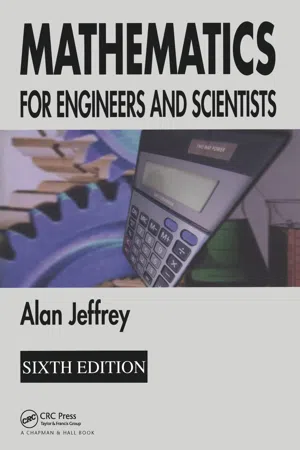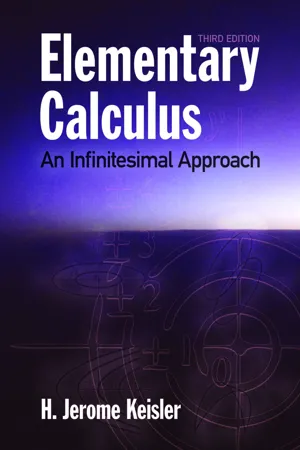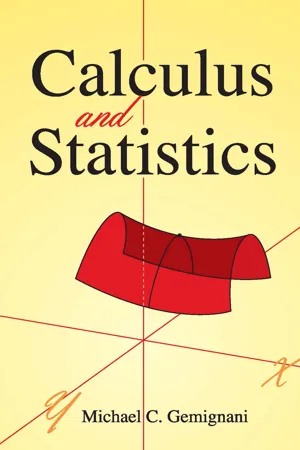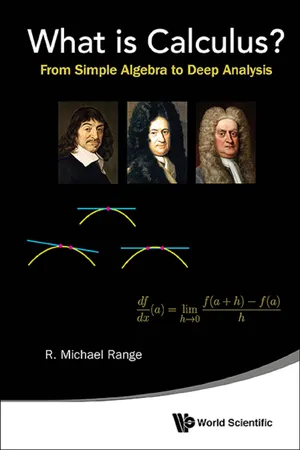Mathematics
Integration Formula
An integration formula is a mathematical expression used to find the integral of a function. It provides a systematic way to calculate the area under a curve or the accumulation of quantities over a given interval. Integration formulas can take various forms, such as power rule, substitution rule, and integration by parts, and are fundamental in calculus.
Written by Perlego with AI-assistance
Related key terms
6 Key excerpts on "Integration Formula"
- eBook - ePub
- Alan Jeffrey(Author)
- 2004(Publication Date)
- Chapman and Hall/CRC(Publisher)
The connection between differentiation and integration is basic to the whole of the calculus and is contained in a result we shall prove later known as the fundamental theorem of calculus. Once again, limiting operations will play an essential part in the development of our argument. In fact we will show not only how they enable a satisfactory general theory of integration to be established, but also how they provide a tool, albeit a clumsy one, for the actual numerical integration of functions. However, aside from a number of simple but important examples, the practical details of the evaluation of integrals of specific classes of function will be deferred until Chapter 8. We begin by seeking to determine the shaded area I of Fig. 7.1 which is interior to the region bounded above and below by the curve y=f (x) and the x -axis, respectively, and to the left and right by the lines x = a,x = b. This approach will lead naturally to what is called the definite integral of f (x) over the interval a ≤ x ≤ b, and it illustrates a valuable geometrical interpretation of the process of integration. Although we use the definite integral to give precise meaning to the notion of the area contained within a closed curve, this appeal to geometry is not actually necessary when defining a definite integral. Indeed, we shall also show how a purely analytical definition of a definite integral, quite independent of any geometrical arguments, may be formulated. Let f (x) be a non-negative continuous function defined in the closed interval [ a, b ] and consider, for a moment, the conceptual problem that arises when trying to determine the area I defined by it in Fig. 7.1 - eBook - ePub
Elementary Calculus
An Infinitesimal Approach
- H. Jerome Keisler(Author)
- 2013(Publication Date)
- Dover Publications(Publisher)
4
INTEGRATION
4.1 THE DEFINITE INTEGRAL
We shall begin our study of the integral calculus in the same way in which we began with the differential calculus—by asking a question about curves in the plane.Suppose f is a real function continuous on an interval I and consider the curve Y = F(X). Let A < B where a, B are two points in I, and let the curve be above the x-axis for x between A and B; that is, f(x) ≥ 0. We then ask: What is meant by the AREA of the region bounded by the curve Y = F(x), the x-axis, and the lines x = A and x = b? That is, what is meant by the area of the shaded region in Figure 4.1.1 ? We call this region the region under the curve Y = F(X) between A and B.Figure 4.1.1The simplest possible case is where f is a constant function; that is, the curve is a horizontal line f(x) = k, where K is a constant and K ≥ 0, shown in Figure 4.1.2 . In this case the region under the curve is just a rectangle with height K and width B – a, so the area is defined asThe areas of certain other simple regions, such as triangles, trapezoids, and semicircles, are given by formulas from plane geometry.Figure 4.1.2The area under any continuous curve Y = f(x) will be given by the definite integral, which is writtenBefore plunging into the detailed definition of the integral, we outline the main ideas.First, the region under the curve is divided into infinitely many vertical strips of infinitesimal width dx. Next, each vertical strip is replaced by a vertical rectangle of height f(x), base dx, and area F(x) dx. The next step is to form the sum of the areas of all these rectangles, called the infinite Riemann sum (look ahead to Figures 4.1.3 and 4.1.11 ). Finally, the integral is defined as the standard part of the infinite Riemann sum.The infinite Riemann sum, being a sum of rectangles, has an infinitesimal error. This error is removed by taking the standard part to form the integral. - eBook - ePub
- Frank Werner, Yuri N. Sotskov(Authors)
- 2006(Publication Date)
- Routledge(Publisher)
5 Integration
In differential calculus we have determined the derivative f′ of a function f. In many applications, a function f is given and we are looking for a function F whose derivative corresponds to function f. For instance, assume that a marginal cost function C′ is given, i.e. it is known how cost is changing according to the produced quantity x, and we are looking for the corresponding cost function C. Such a function C can be found by integration, which is the reverse process of differentiation. Another application of integration might be to determine the area enclosed by the graphs of specific functions. In this chapter, we discuss basic integration methods in detail.5.1 INDEFINITE INTEGRALS
We start with the definition of an antiderivative of a function f.Obviously, the antiderivative is not uniquely determined since we can add any constant the derivative of which is always equal to zero. In particular, we get the following theorem.Definition 5.1 A function F : DF → ℝ differentiable on an interval I ⊆ DF is called an antiderivative of the function f : Df = DF → ℝ ifTheorem 5.1 If function F : DF → ℝ is any antiderivative of function f : Df → ℝ, then all the antiderivatives F* of function f are of the formBy means of the antiderivative, we can now introduce the notion of the indefinite integral, which is as follows.where C ∈ ℝ is any constant.Definition 5.2 Let function F : DF → ℝ be an antiderivative of function f. The indefinite integral of function f, denoted by ∫ f(x) dx, is defined aswhere C ∈ ℝ is any constant.The relationship between differentiation and integration can be seen from the following two formulas. We haveFunction f is also called the integrand, and as we see from the above definition, the indefinite integral of function f gives the infinitely many antiderivatives of the integrand f. The notation dx in the integral indicates that x is the variable of integration, and C denotes the integration constant. - eBook - ePub
- Michael C. Gemignani(Author)
- 2014(Publication Date)
- Dover Publications(Publisher)
Integration7.1 THE DEFINITE INTEGRAL. AREA UNDER A GRAPHIn Section 5.5 we had occasion to find the area between the graph of certain functions and the x-axis over particular intervals. In both instances (Examples 18 and 19 of Chapter 5 ), the areas concerned were standard geometric figures to which well-known area formulas could be applied. The area between the graph of f(x) = x2 and the x-axis over the interval [0, 1], the shaded portion of Fig. 1 , cannot be found, however, through the application of some standard area formula. If we are to find this area, then, we must do some trailblazing. That is, we must define what we mean by the area of a geometric configuration (such as that shown in Fig. 1 ) which does not fall into one of the “nice” categories for which we already have area formulas. This situation is analogous to our earlier problem of taking the sum of infinitely many numbers. Since we had only the sum of finitely many numbers defined to start with, we had to define what should be meant by the sum of infinitely many numbers. In that case, our definition of infinite sum had to be consistent with (that is, not contradict) what we knew about finite sums. Here, our extended definition of area must be such that it does not contradict the area formulas we already know.Fig. 1Fig. 2Let the area presented in Fig. 1 be denoted by A. Then A lies inside a square with side 1 (Fig. 2 ). Since the area of this square is 1, then A ought to be less than 1 if it is to be consistent with the usual area formulas. Moreover, the shaded area also lies inside the triangle with vertices (0, 0), (1, 0), and (1, 1) (Fig. 2 ). Since the area of this triangle is , then A should be less than .We now partition [0, 1] into four equal closed subintervals [0, ], [ , ], [ , ] and [ , 1]. Over each of these subintervals we erect a rectangle of height f(r) = r2 , where r is the right-hand endpoint of the subinterval (Fig. 3 - eBook - ePub
What is Calculus?
From Simple Algebra to Deep Analysis
- R Michael Range(Author)
- 2015(Publication Date)
- WSPC(Publisher)
Taylor’s Theorem with Remainder . As an application, we then verify the convergence statements we had made in Section III.9, and we shall place these results in a broader context.IV.9.1 An Application of Integration by Parts
Suppose f is an algebraic function, or more generally, a function whose derivatives of any order exist on an interval I . The derivatives of f are then continuous and hence bounded on any closed bounded interval contained in I . Therefore, by Theorem 6.2 , any such derivative is then integrable. Fix a point a ∈ I . Since f is an antiderivative of D (f ), the Fundamental Theorem of Calculus implies thatWe now fix x and apply integration by parts to the integral on the right side, in the form ∫ f ′dg = f ′ g − ∫ g d (f ′), where we choose g so that dg = 1dt , that is, so that g ′ = 1. Hence g (t ) = t + c , where we are free to choose the constant c . It follows thatThe right side is an antiderivative of f ′ on the left. By the Fundamental Theorem of Calculus (Part 2) one therefore obtainsIn order to simplify this expression, we choose c = −x , so that the first term vanishes. (Remember: we treat x as constant; differentiation and integration are with respect to t !) We eliminate the minus signs in the preceding formula by interchanging the order in the resulting terms (a − x ) and (t − x - eBook - ePub
The Learning and Teaching of Calculus
Ideas, Insights and Activities
- John Monaghan, Robert Ely, Márcia M.F. Pinto, Mike Thomas(Authors)
- 2023(Publication Date)
- Routledge(Publisher)
F. Indeed, an infinite number of functions don’t have nicely-expressed antiderivatives. But for the ones that do, there are a number of clever techniques for finding an antiderivative. These techniques of integration (e.g. partial fractions, trigonometric substitution, integration by parts) are usually parts of a calculus course; indeed, in some calculus courses they comprise the bulk of the integration section of the course. Here we discuss two of these techniques, and how they work: integration by substitution and integration by parts. We focus on these two techniques because they are very widely used and also because they provide windows into the relationship between integration and differentiation, rather than just being clever tricks for evaluating integrals.5.3.6.1 Integration by substitution
MathematterTo evaluate the integral,you might do this substitution:∫ 0 πx sinx 2d xu =x 2du=2x dx1 2d u = x d xThus.∫ 0 πx sinx 2d x =∫ 0 π1 2sin u d u .Evaluating using the FTC, this integral equals−, which is 1.1 2cos π −−1 2cos 0In this process, what does the equation = 2x dx mean?Why exactly do you know that the two integrals are equal?We hope you think about this question before reading on. Students are commonly taught the technique of integration by substitution as a symbolic method that happens to work but does not have much other meaning.Suppose we view each integral as a sum of rectangular areas. For the original integral, we imagine the domain∫ 0 πx sinx 2d x0 < x < πpartitioned into uniform widths of size dx. Each of these corresponds to a little rectangle with width dx and height xsin x2 . Four example rectangles are illustrated in the top of Figure 5.21 . The y = x sin x2 integral thus measures the area under one hump of the graph of y = x sin x2 , above the x-axis.Area preserved by variable substitution in an integralFIGURE5.21Through the u-substitution, the integral becomes, which measures the 2 area under one hump of the graph, y =∫ 0 π1 2sin u d uy =above the u-axis. These areas are the same! In Figure 5.21 , each example rectangle in the first integral has a corresponding same-area rectangle in the second region. But note that the widths are no longer uniform; since; du = 2x dx; if the dxs are uniform then the du1 2sin u
Learn about this page
Index pages curate the most relevant extracts from our library of academic textbooks. They’ve been created using an in-house natural language model (NLM), each adding context and meaning to key research topics.





